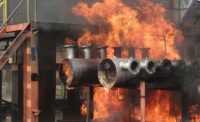
Today’s electrical workers face many challenges when performing daily tasks. Not only must they comply with safety procedures to make sure they are protected from risk, they must face extreme conditions including the environment. Most concerns revolve around heat and high humidity, and many companies are attempting to address this need with lighter, more breathable garments. But what about the other end of the spectrum — tasks that must be performed in cold weather?
Three hazards
The proper selection of electrical personal protection equipment (PPE) for the worker in a cold weather environment should start with an understanding of the hazards faced by the worker. There are three hazards that must be addressed:
- Shock
- Flash
- Blast
Shock value
The focus for electrical protection today is on arc flash, but shock still kills more workers every year than arc flash. Protection from shock should be one of the first things to consider in selecting the proper PPE regardless of weather. Proper voltage-rated gloves, compliant with the requirements of ASTM D120, are a must when working on or near 50 volts or more. A leather glove protector should be worn at all times over the voltage-rated rubber gloves. These leather protectors offer protection for the voltage-rated gloves from the possibility of punctures or cuts. Plus, they will also help to keep hands warm. The addition of a glove liner, worn under the voltage-rated gloves and leather protectors, will help keep hands warm. These liners come in both silk and cotton materials and help to alleviate any discomfort in any environment.
Flash of light
Complete a hazard risk analysis of your equipment before choosing PPE for flash protection. This will help you select the best PPE for arc flash occurrence. Comfort of the clothing is always second to the protection level. In cold weather, an insulated jacket and bib overall or insulated coverall in a “Duck” fabric are available in flame-resistant (FR) fabrics, for instance.
PPE working together
When selecting PPE, make sure you think of other PPE workers will be wearing to make sure they integrate properly with each other. For instance, the worker will most likely be required to wear voltage-rated rubber gloves and leather protectors. Most companies offer sleeves on their jackets with either an open cuff or with a knit wristlet sewn onto the jacket sleeve. An open cuff is very difficult to keep covered with a voltage-rated rubber glove due to the cuff being pushed back up on the forearm by not fitting properly inside the rubber glove. The folded cuff inside the glove can also cause discomfort. Cuffs sewn to the end of the sleeve cause a “pillowing” effect of the sleeve. This causes the sleeve to be pushed up on the forearm, separating the sleeve from the voltage-rated rubber glove and exposing the skin.
The best solution is to look for a jacket with the cuff sewn inside the end of the sleeve with an overlap of fabric forming the cuff. This allows for a straight fit into the voltage-rated rubber glove to prevent the jacket from pushing up on the forearm. Adding straps with Velcro® will help tremendously to streamline the sleeves for a good integration of gloves and jacket and eliminate the possibility of skin exposure.
Regardless of the weather…
There are a few FR-rated fall protection harnesses available on the market today. Face and head protection also depends upon the hazard risk analysis performed on your equipment. As with other PPE, the proper face and head protection for the hazard potential must be worn regardless of weather conditions.
However, there are options that will provide cold weather comfort while complying with the necessary ATPV rating needed. The most obvious would be to wear a double-layer balaclava. (Picture the hood a race car driver wears under his helmet.) There are other tasks which may require the use of a double-layer switching hood in order to be compliant. In some cases this hood alone may not be warm enough, but adding a balaclava under the hood will significantly increase warmth.
Keeping all three hazards in mind when selecting your PPE is critical to implementing a successful safety plan. With today’s options in clothing and a better understanding of the workers’ needs, the employer can equip his employees with the proper PPE for the task as well as provide a comfortable solution.



